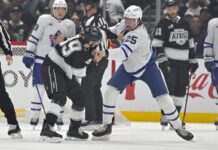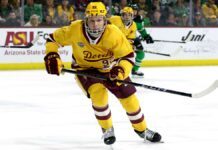It is finally over.
William Nylander‘s new deal is six years long and totals $41.77 million. Because it was signed in the middle of the season, the cap hits vary in the first year compared to the rest and are as follows:
2018-19: $10,277,778
2019-24: $6,962,366
While I wouldn’t go as far to say that this deal had to get done, the reality is the Leafs are legitimate Cup contenders this season. This opportunity does not come around all the time, especially in a league that tries to implement as many rules as possible to ensure parity. While the Leafs are built for the long-run (and this isn’t an article on how long their Cup window will be open), they are healthy right now, John Tavares and Frederik Andersen are in their late 20s and each is having a career season, and the Leafs haven’t had to trade away players they can’t afford yet.
To go into the playoffs with the best roster the team has had in over a decade while a legitimate all-star talent sits at home watching because they couldn’t agree to a deal would have been tragic for the team and the individual.
Now, in probably a week or so, we’ll finally get to see the full lineup everyone dreamed about all summer.
Before we get to that, though, a few notes on the deal.
Darren Dreger broke the deal and noted on Sportscenter that the Leafs really wanted this deal to come in around $6.5 million (it was unclear if that was their original thought or if that developed over time). To some degree, there’s no question the Leafs caved at least a little as this was not the number they originally planned on. Brian Burke spoke out against the contract on the HNIC broadcast, saying:
“I do believe [Nylander won the negotiation]. The notion that you’ll put more money on the table late, that’s a lesson that the agents for these other players are going to learn that with Toronto all you have to do is hold out and they’ll up the ante. That’s dangerous ground.”
To some degree, it’s a fair point, although there are a few angles to also consider. The first is that a holdout is not necessarily agent-driven – the player has to be the one to do it, at the end of the day. Many won’t, and many also don’t have a wealthy family such as Nylander’s supporting it. There was a lot of criticism directed at Nylander for his holdout, something many players would not be willing to go through for a payoff that was ultimately not a massive win for Nylander.
I also don’t think the number was a big enough win to impact negotiations moving forward (plus, each negotiation is entirely unique). Throughout the week leading up to the signing, I tried digging for information, and while nobody knew much (including Nylander himself!), most expected the number to come in around $6.8 or $6.9 million. I know there’s mixed reviews out there, but generally speaking, I don’t think anyone was too surprised at the number it came in at. Was it a little high? Yes. Was it jaw-dropping to the point where the other upcoming RFAs should follow suit and hold out? No.
The last point is that the contract is trade-able. Players are not eligible for no-trade clauses until they are UFA eligible in the NHL and we’ve seen multiple players traded before it kicks in – PK Subban, Mike Richards, Jeff Carter, etc. On Nylander’s side, there was and probably still is a definite concern there that he can be traded at any time, but he can rest assured he’s locked in on a good contract now. On the Leafs’ end, this deal is extremely trade-able. At any point in the contract, they could conceivably put Nylander on the market and his contract would not be a hindrance in moving him. He’s not making elite money, and even though he is paid slightly more than many all-stars, it’s not a big enough number that teams wouldn’t be able to afford him, or think he’s not worth his money.
In terms of fitting Mitch Marner and Auston Matthews in alongside him (and John Tavares), we’ll save that conversation for another day. Now, let’s enjoy watching this full squad play some hockey.
Notes
– A few weeks ago, I mentioned that teams were completely selling out on Mitch Marner on the half-wall on the power play, and without Auston Matthews on the other side, the Leafs couldn’t make them pay for doing so (although they still clicked at roughly 19 percent on the PP without Matthews, which is respectable). Watch the video below where San Jose sells out on Marner on the half-wall and the puck gets worked around to Matthews, who makes no mistake. Tavares was filling this spot in Matthews absence and while he’s a goal scorer in his own right, he can’t beat goalies clean the way Matthews can:
– Auston Matthews, by the way, has 13 goals in 13 games so far this season.
– A few seasons ago, the Leafs put Dion Phaneuf on the top power-play unit and it helped inflate his stats, as he had 24 points in 51 games as a Leaf before he was traded that season. I’m not suggesting that the Leafs are intentionally lowering Jake Gardiner’s value, but he clearly is taking a production hit by not getting any time with the top unit (nor should he with the way Morgan Rielly is producing). Perhaps Nylander’s return will give him a boost, but heading into free agency, Gardiner’s on pace for three goals and 33 points. Yes, that would impact his contract.
– End-of-the-game-to-protect-a-lead tracker: Against Minnesota with the goalie pulled, the Tavares line was on with Ron Hainsey and Nikita Zaitsev on defense.
– Nikita Zaitsev was actually second on the team in time on ice that game. Similar to Gardiner but even more extreme, once he was taken off the power play following his rookie season, his production has fallen on a cliff. He’s currently on pace for six points this season. That is no way to judge a defenseman, but to be third on this team in ice time per game (and third in even strength ice time per game) and to only produce in that neighbourhood is truly unbelievable. With that ice time and the surrounding forward group, you should be able to get 15 points just by passing the puck up ice, but that is a consistent struggle for Zaitsev.
– I know the Leafs’ scoring gets a lot of attention, but they actually have the third best team save percentage in the league this season. The Wild game was the latest example of Frederik Andersen standing on his head. While the Leafs do have more shooting talent than the average team, it’s also worth noting that their PDO is the highest in the league (they actually finished second in the league last season there). Currently, it is over 103, and the last team to be over that number over a full season was the 2009-10 Washington Capitals.
– In October, Mitch Marner averaged 49 seconds per game shorthanded and John Tavares was at 35 seconds per game. In November, those numbers dropped to 39 seconds and 11. I think part of that had to do with the Matthews injury (Tavares’ even strength time on ice went up nearly a minute in November), but the penalty kill is rolling now. With a healthy roster, will Tavares and Marner see their penalty kill time go up? This is something to keep an eye on.
– All of last week, Mike Babcock spoke of Nylander as if he will definitely be on the team, but Kyle Dubas admitted they only agreed to a deal with less than an hour to go. All week I was wondering if he knew something the rest of us didn’t, but it turns out he was just as hopeful as the rest of Leafs Nation. Something to remember when the next rumour mill comes around, too.
Quotes
“We should play them 20 times going into the playoffs … we need to understand how heavy and how hard it is. We’re fun to watch, no question, but just because you’re fun to watch doesn’t mean you get to play a long time in the spring.”
– Mike Babcock after the Leafs’ game against the Wild in which they were outshot 41-23
It’s great that the Leafs finally have their full roster, but I believe it’s going to take some work to get this group into a groove and going all at the same time. Kadri struggled at the beginning of the season as the defacto 3C on a line that was really doing nothing (although they created some nice opportunities vs. Minnesota Saturday). Nylander’s return is going to shift around some players and have a trickledown effect (which is positive, but means time is needed to gel). Someone could be asked to play their off-wing here. These are good problems, but I do think it will take time.
“We’ve got to go through the same protocol you’d go through coming in from training camp. I would say patience with that. He’s got to go through his medical testing. Though everyone wants to get back and get playing, we’ve still got to play the long game with it. It’s a six-year contract and we don’t want to rush to get him in on Tuesday or Thursday and have that forgo his health and well-being. We will get that all taken care of and we’ll hope in the next week or so he’ll be back in action.”
– Kyle Dubas on integrating Nylander back into the roster
This is the correct approach. You can’t just walk into the NHL in the middle of the season.
“Look at the lineup. They got two of the best centers in hockey, they got speed, they can score, they got a great PP and I know the goalie’s great & they’re a really good road team so everything about them is a challenge.”
– Bruce Boudreau on the challenge of playing the Leafs
There are probably two remaining weaknesses here: the defense and the overall ability to control play. One of those might see a significant boost (controlling play) now that they are fully healthy for the first time this season, while the other would benefit as a result of it. Otherwise, this team is a complete matchup nightmare.
5 Things I Think I’d Do
1. Now that William Nylander is back, I think I’d at least plan to ease him back in the lineup. Unlike Matthews when he returned, Nylander hasn’t played a single game this season. I know he’s been on the ice and conditioning, but we’re in midseason form at this point and it’s very difficult to just step right into the NHL in the middle of the season. Obviously, I’m not at practice seeing what he looks like, but in general, I’d be aiming for him playing next Saturday against Boston at the earliest.
2. I think this week is one final audition for the last forward spot once Nylander returns and it is between Tyler Ennis and Josh Leivo at this point. The inside edge right now has to go to Ennis solely because he is a lefty that is more comfortable on the left wing. On occasion, Leivo has shifted to the left side and he has not looked nearly as comfortable (particularly when picking pucks up off the wall). Ultimately, I think Babcock can platoon the two, but Ennis likely stays in to start as someone who has been playing left wing for the past month. The handedness is a tiebreaker for two players that have been reasonably even as far as performance goes.
3. I think I’d also not hesitate to move Par Lindholm to the left wing again inside the top nine if Andreas Johnsson struggles (who is really the only realistic candidate unless someone plays their off-wing). He didn’t do anything special on the left wing, but he was comfortable, he’s responsible, he has some skill, and he can take shifts in whatever matchup/role the team would want there.
4. When we talk about resting Frederik Andersen and getting Garret Sparks in the net a little more frequently to at least spell Andersen out and further evaluate Sparks, I think the game this Thursday against the Detroit Red Wings would be a good opportunity to do so.
5. I think I’ll wait at least a few weeks before discussing the Auston Matthews and Mitch Marner contract negotiations.



































